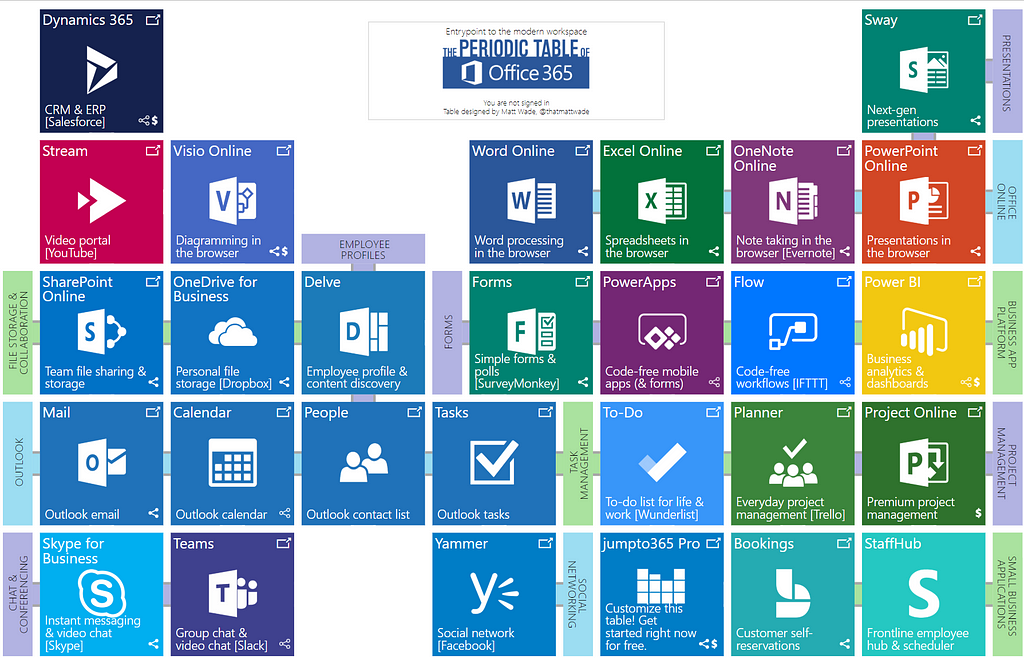The Price of Innovation

Are Microsoft IT Pro’s suffering from information overload?

We must by now have seen Matt Wade’s Periodic Table of Office 365 features.

And every time I show customers, the general response is: “I did not know that”. Typically, when I ask customers about their journey to the cloud, they are always “Yes, we have Office 365” which usually translates to “We have moved our mailboxes and we have Office ProPlus”.
Now, with every journey, there is a beginning, and moving the mailbox usually is the first step. But what happens after that? And once you’ve moved your content to the cloud, what then? Are you expected to do cool stuff, innovate, get the business excited about the cool new features?
Let’s stop for a moment and consider how we used to work with Microsoft technology:
Circa: Before Office 365/BPOS
As part of your license agreement with Microsoft, you were generally guaranteed a new product every 3 years, which meant that you, as an IT person would have to skill up every 36 months to be geared towards the new tech that may or may not come.
In today’s cloud world, we on a 3 week release cycle and I use that term lightly because new features are added daily. Customers now no longer buy versions of software, they buy subscriptions to ever changing software. Dare I say that we will no longer have version years since everything in the cloud is timeless?
Go have a look at your M365 Message Center notifications for June 2019, or any month for that matter. Go count how many changes/features/updates have rolled out. Its scary. We live in this “Always On” world where things are switched on as soon as they are available. As a consultant, its awesome because its new which means I get to tell people about it; Ergo, I’m the interpreter which keeps me employed but what does it mean for the IT Team at companies?
- Business consumes IT faster than IT can provision it
- Business circumvents IT because IT cannot keep up with innovation — Not shadow IT because its the products in Office 365 that they start consuming without IT
- IT is seen as not understanding business because they did not show business all the coolness — Not that this is a new thing but come on people!
- IT becomes marginalized
Then something happens with the tool that business started using that IT doesn’t support “yet” and it becomes a big fight.
SO how do we fix this huge shift in the force?
- Office 365 or even its larger sibling Microsoft 365 is still a huge grouping of products and should be seen that way. Individual products.
- Citizen Developers are great for innovation but not so much for governance so start with governance first.
4. KBYG — Know Before You GO. Spend the time upfront, before you hit that Exchange Migration button and move your identities to the cloud.
5. Get your teams understanding what is in the cloud. Even if that means you get a consultant in there for a week or two to speak to your IT team.
6. Continuous Learning — Your IT department has to accept that this is the new normal.
In closing, at the rate of change that we see product updates roll out, your IT Team has no option but to change how they operate but remember, you must want to. IT needs to change because the products has changed. The cloud world is very different from on-prem and IT Pro’s need to get a handle of that.
If you enjoy this post, please hit the “recommend” (heart) icon. Also, you can catch us on our Facebook page or YouTube Channel for more interesting thoughts and articles on all things Regarding Microsoft 365.
Be cool my ninjas.
The Price of Innovation was originally published in REgarding 365 on Medium, where people are continuing the conversation by highlighting and responding to this story.
